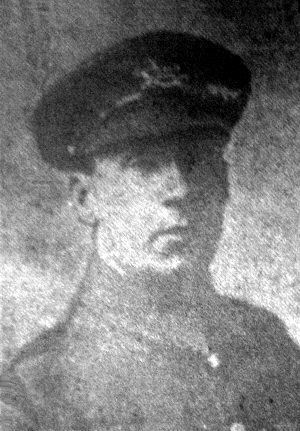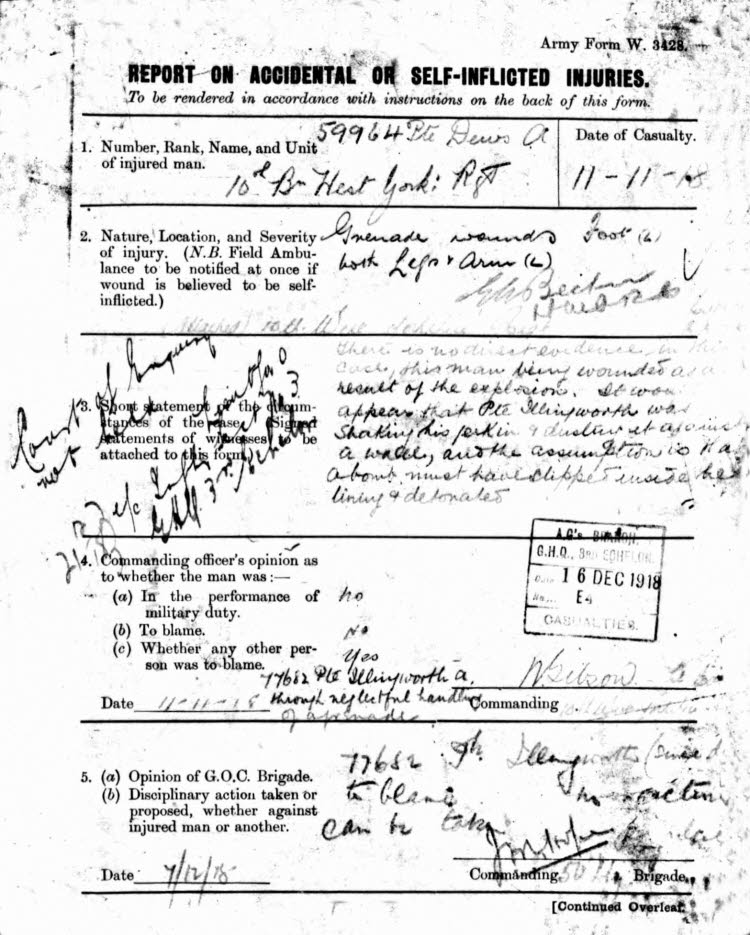
Arthur Dews was born in the Wakefield area in 1893, the son of miner Thomas William Dews and Louisa (nee Lindley) who married in late 1880. In 1901 the family are living on South Parade, Ossett and Arthur has siblings Mary (19), Louisa (8) and Beatrice (1).
By 1911, the Dews family has grown and they are now living in a three-roomed house at 10, Haggs Hill Road, Ossett. Arthur has three sisters and a brother, Willie (born 1904). There are two ‘boarders’ in the household too, bringing the total in the house to eight people. Arthur is aged 17 and a coal teamer working underground, most probably at the nearby Roundwood Colliery.
Thomas William and Louisa Dews had ten children in their 30 years of their marriage, but five died before 1911. Arthur’s father, Thomas William, died in September 1913, aged 61 and his youngest sister, Beatrice, died in 1911. By 1919, all his surviving sisters had all married.
Arthur Dews enlisted on the 12 December 1915 and was on ‘B’ Reserve until the 23rd April 1918 when he was appointed to the Training Reserve Battalion at Clipstone Camp on the 27th April. On the 21 May 1918 he transferred to the 3rd Battalion, West Yorkshire Regiment. Private Dews, 59964 embarked for France on the 4th September 1918. Arthur was 5’ 4½” tall and weighed 131 lbs with a dark complexion, green eyes and brown hair. His physical development was described as ‘good’.
On the 10th September 1918, Arthur joined his Regiment in the field and on the 20th September he was declared missing but managed to re-join his Regiment the next day. His good fortune was to be short lived because on the 11th November 1918, Armistice Day, Arthur Dews was injured and exactly one month later. on the 11th December 1918, he died from what the army called “acc GSW foot & legs”, which in fact, wasn’t quite the case.
Arthur Dews didn’t die from the effects of a gunshot wound; he was the victim of a tragic accident which caused some confusion to the Army bureaucracy. The instruction to D.A.G. GHQ 3rd Echelon on the 14th December 1918 read “Forwarded for record. This casualty should be reported as died (crossed out), injured (actual).” It was much more serious than an injury on Armistice Day, as well the Army knew. Arthur had lost his life as a result of neglect by one of his comrades. A hand-grenade was accidentally set off by Private Arthur Illingworth. The explosion killed Illingworth almost instantly, severely injuring Private Arthur Dews and Private Geoffrey Grayson, who both later died from their wounds. Two other men: Private Belton and Private Kitching were also injured, but both survived.

The report of the tragic incident reads:
“There is no direct evidence in this case. This man being wounded as a result of the explosion. It would appear that Pte. Illingworth was shaking his jerkin and dusting it against a wall and the assumption is that a bomb must have slipped inside the lining and detonated. Although no Court of Enquiry was held the record indicates 77682, Pte. Illingworth at fault for neglectful handling of a grenade. No action can be taken.”
No action could be taken because 20 year-old, Private Arthur Illingworth, 77682, of Farsley, 10th Battalion, West Yorkshire Regiment (Prince of Wales’s Own), died of his wounds on the 11th November 1918. Private Illingworth’s Service Record has survived and it reveals that five soldiers were killed or injured in the accident. In addition to Arthur Dews and Arthur Illingworth, the others were: 77558, Private Kitching, 77890, Private Grayson and 77904, Private Belton.
Witness statements were taken from two other soldiers, including Private Hall who wrote:
“In the field on the 11th November 1918, I was approaching the billet and I saw 77682, Private Illingworth shaking his leather jacket about one yard away from the wall of the billet. When I reached the topmost step leading to the billet I heard an explosion. I turned round and saw several men lying on the ground wounded. I then fetched the stretcher bearers who took the wounded to the Aid Post. At this time a crowd gathered around and I went into the billet.”
Private Illingworth had suffered severe injuries to his abdomen, both thighs and both legs and died the same day. His service record includes a short statement as to the circumstances of the tragedy. No direct evidence can be ascertained as to how the accident happened and the condition of Private Illingworth was so precarious that it was impossible to interrogate him upon the matter. It is assumed that Private Illingworth was removing dust from his jerkin by beating it against a wall and by some means, a live grenade had got into the torn lining of the jerkin, and the action of the bomb striking the wall caused the explosion.
On the 12th November 1918, Private Geoffrey Grayson, 77890, also died of his wounds incurred in this incident. Private Grayson was from Rotherham, one of twelve children and he had only been in the field since the 26th October 1918. He died as a result of a serious grenade wound to the head. Private Kitching and Private Belton appear to have been more fortunate than their colleagues, although it is not known if they too suffered serious injuries. On the 26th April 1919 the Army returned Arthur Dews’ possessions to his widowed mother. Sadly it seems that one of his possessions, a cat mascot, was far from lucky.
Private Arthur Dews was not remembered for his war service and subsequent accidental death on the Ossett WW1 War Memorial listing, but we feel that his sacrifice should not be forgotten.
Private Arthur Dews, aged 24 years, the son of Thomas William and Louisa Dews, of 10, Haggs Hill, Ossett, died from accidental wounds on the 11th December 1918 and is buried at grave reference I. D. 29. at Beaulencourt British Cemetery, Ligny-Thilloy 1, Pas de Calais, France. Beaulencourt is a village on the RN17 south of Bapaume, a town 20 Kms south-south-west of Arras.
The cemetery was made originally by the 3rd, 4th, 43rd and 58th Casualty Clearing Stations, which were posted in Beaulencourt at different periods after the middle of September, 1918; and the burials from these hospitals are in Plot I, Rows A to D. It was greatly enlarged after the Armistice by the concentration of graves from the neighbouring battlefields and from certain other cemeteries.
There are now over 700, 1914-18 war casualties commemorated in this site. Of these, over 300 are unidentified and special memorials are erected to 21 soldiers from the United Kingdom known or believed to be buried among them. The cemetery covers an area of 2,917 square metres and is enclosed on three sides by a rubble wall.
References: